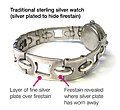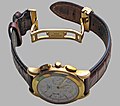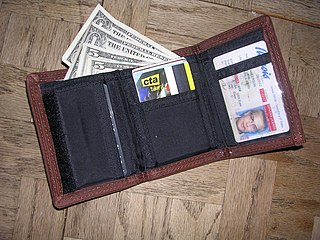
A wallet is a flat case or pouch, often used to carry small personal items such as physical currency, debit cards, and credit cards; identification documents such as driving licence, identification card, club card; photographs, transit pass, business cards and other paper or laminated cards. Wallets are generally made of fabric or leather, and they are usually pocket-sized and foldable.

Cufflinks are items of jewelry that are used to secure the cuffs of dress shirts. Cufflinks can be manufactured from a variety of different materials, such as glass, stone, leather, metal, precious metal or combinations of these. Securing of the cufflinks is usually achieved via toggles or reverses based on the design of the front section, which can be folded into position. There are also variants with chains or a rigid, bent rear section. The front sections of the cufflinks can be decorated with gemstones, inlays, inset material or enamel and designed in two or three-dimensional forms.

A strap, sometimes also called strop, is an elongated flap or ribbon, usually of leather or other flexible materials.
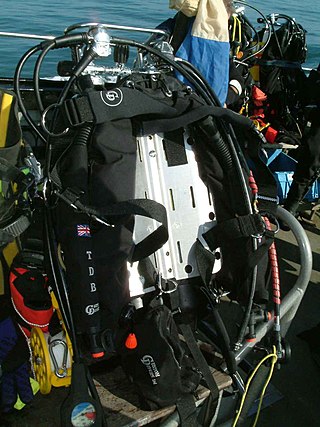
A backplate and wing is a type of scuba harness with an attached buoyancy compensation device (BCD) which establishes neutral buoyancy underwater and positive buoyancy on the surface. Unlike most other BCDs, the backplate and wing is a modular system, in that it consists of separable components. The core components of this system are:

Citizen Watch Co., Ltd. is an electronics company primarily known for its watches and is the core company of a Japanese global corporate group based in Nishitokyo, Tokyo, Japan. In addition to Citizen brand watches, it is the parent of American watch company Bulova, and is also known for manufacturing small electronic devices such as calculators.
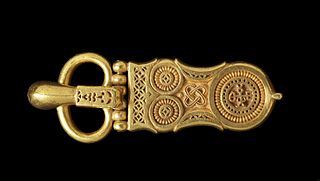
A belt buckle is a buckle, a clasp for fastening two ends, such as of straps or a belt, in which a device attached to one of the ends is fitted or coupled to the other. The word enters Middle English via Old French and the Latin buccula or "cheek-strap," as for a helmet. Belt buckles and other fixtures are used on a variety of belts, including cingula, baltea, baldrics and later waist-belts.

The Rolex Oyster Perpetual Submariner is a line of sports watches designed for diving and manufactured by Rolex, resistant to water and corrosion. The first Submariner was introduced to the public in 1954 at the Basel Watch Fair. It was the first watch to be waterproof up to 100 metres (330 ft). The Rolex Submariner is considered "a classic among wristwatches", manufactured by one of the most widely recognized luxury brands in the world. Due to its huge popularity, there are many homage watches by well-established watchmakers, as well as illegal counterfeits. The Rolex Submariner is part of Rolex's Professional line.
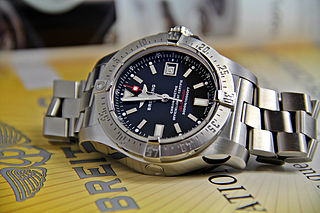
A diving watch, also commonly referred to as a diver's or dive watch, is a watch designed for underwater diving that features, as a minimum, a water resistance greater than 1.1 MPa (11 atm), the equivalent of 100 m (330 ft). The typical diver's watch will have a water resistance of around 200 to 300 m, though modern technology allows the creation of diving watches that can go much deeper. A true contemporary diver's watch is in accordance with the ISO 6425 standard, which defines test standards and features for watches suitable for diving with underwater breathing apparatus in depths of 100 m (330 ft) or more. Watches conforming to ISO 6425 are marked with the word DIVER'S to distinguish ISO 6425 conformant diving watches from watches that might not be suitable for actual scuba diving.
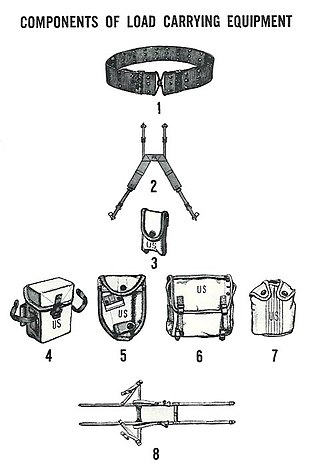
The M-1956 Load-Carrying Equipment (LCE), also known as the Individual Load-Carrying Equipment (ILCE), was developed by the U.S. Army and first issued in the early 1960s. The M-1956 LCE was designed to replace the M-1945 Combat Pack, the M-1923 cartridge belt, the M-1936 pistol belt and the M-1937 BAR magazine belt. The M-1956 LCE was designed to be quickly configured, using no tools, to accommodate various mission and ammunition loads. The M-1956 LCE remained in service through the 1980s and set the standard for future United States military load-carrying equipment.
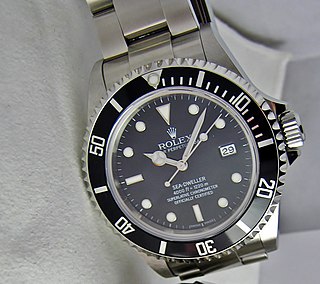
The Rolex Oyster Perpetual Date Sea-Dweller is a line of diver's watches manufactured by Rolex, with an underwater diving depth rating of 1,220 meters and up to 3,900 metres (12,800 ft) for the Sea-Dweller Deepsea variant. In 2022 the dimensionally large Deepsea Challenge Sea-Dweller variant with an official depth rating of 11,000 metres (36,090 ft) was added to the line. The Rolex Sea-Dweller is part of Rolex's Professional line.
The J12 is a line of Swiss made luxury watches introduced in 1999 by French haute couture house Chanel. The J12 was launched in 1999 and is considered as a unisex watch. The watch was designed by the artistic director of the house, Jacques Hélleu, who found inspiration in the two worlds he loved most: automobiles and sailing. Chanel uses highly scratch-resistant ceramic for the watch's case and bracelet. Other materials are used as well, such as titanium and for one of the house's limited edition watches, sapphires were used to create the entirety of the bracelet and case.
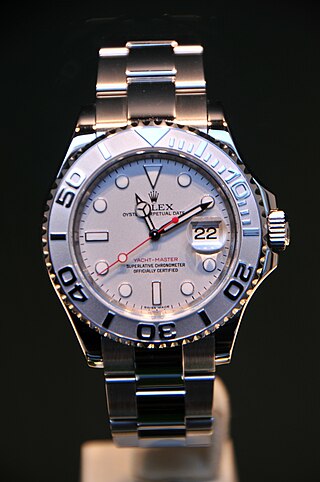
The Rolex Yacht-Master is a luxury sports watch manufactured by Rolex and first introduced in 1992 as Reference 16628 in 18-karat yellow gold. In 1994, Rolex released a lady's model (69628) and a mid-size model (68628) at 35mm, marking the first time in Rolex history that a professional series watch was available in smaller than the standard size case. In 1996, Rolex introduced two-tone to the lady's and mid-size line.
Shock resistant is a common mark stamped on the back of wrist watches to indicate how well a watch copes with mechanical shocks. In a mechanical watch, it indicates that the delicate pivots that hold the balance wheel are mounted in a spring suspension system intended to protect them from damage if the watch is dropped. One of the earliest and most widely used was the Incabloc system, invented in 1934. Before the widespread adoption of shock-resistant balance pivots in the 1950s, broken balance wheel staffs were a common cause of watch repairs.

The Omega Seamaster is a line of automatic winding mechanical diving watches from Omega with a history that can be traced back to the original water-resistant dress watch released in 1948. The Seamaster collection is perhaps best known today for the Seamaster Diver Professional 300m model that has been worn in the James Bond movie franchise since 1995. Originally conceived as a dressy, water-resistant timepiece, the Omega Seamaster has evolved to a robust sports watch line typically with a stainless steel case, robust water resistance, and an official certified chronometer certified movement within. The Diver Professional 300m is most famous for its "train track" five link steel bracelet, its helium release valve at the 10:00 position, the wave pattern dial on certain model generations, and the skeletonized handset.

The Rolex Oysterquartz was a quartz watch made by Rolex.
The Bozeman Watch Company of Bozeman, Montana, was an American company that designed and engineered its own timepieces and had its mechanical components certified by the Contrôle officiel suisse des Chronomètres (COSC) certified timepieces. It went out of business in 2015.
MIL-W-46374 is a specification first published on October 30, 1964, for US military watches. The 46374 was specified as an accurate, disposable watch. In its span, it encompassed metal and plastic cased watches with both mechanical and quartz movements. The 46374 replaced the MIL-W-3818, reducing cost and inheriting the dial from the MIL-W-3818B. These were lower quality watches than the 15 jewel movements, the transition started as US involvement in Vietnam ramped up.
US military watches are watches that are issued to US military personnel.

The TX Watch Company was launched in 2006 by the Timex Group, an international holding group and corporate parent of global watchmaking companies, including Timex Group USA, Inc., TMX Philippines, Inc., and Timex Group India Ltd.

Montres Tudor SA, or simply Tudor, is a Swiss watchmaker based in Geneva, Switzerland. Registered in 1926 by Hans Wilsdorf, founder of Rolex, the brand remains a sister company to Rolex; both companies are owned by the Hans Wilsdorf Foundation. Tudor was initially known for watches produced for the military and professional divers. From the 1960s to 1980s, several navies issued Tudor Submariners to their divers, including the US Navy SEALs and the French Marine Nationale.











